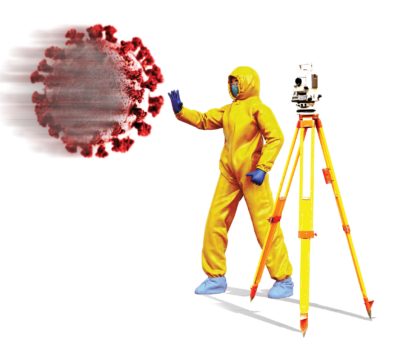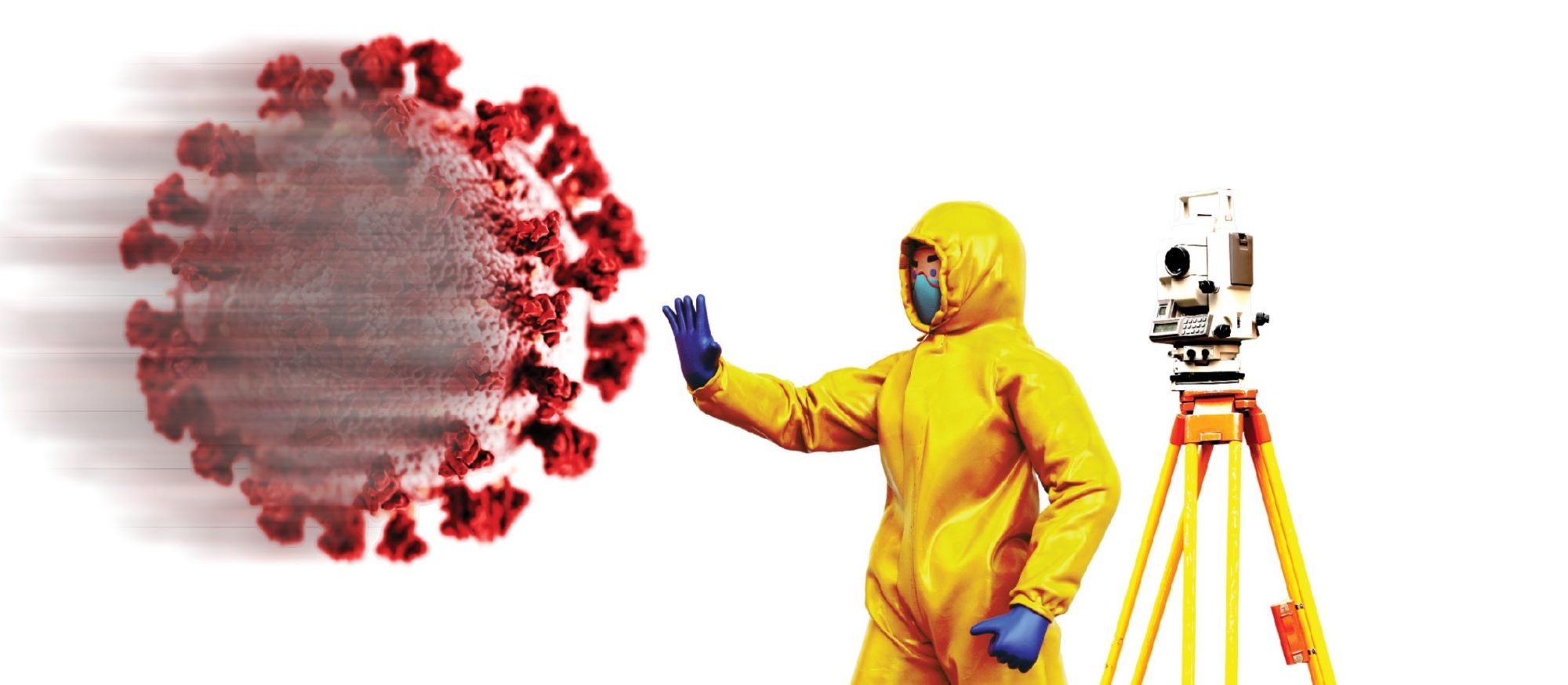Four surveying and mapping colleagues share their experience working through the outbreak
Ed, Board Member and Head of Field Surveys & Mapping Department

With four offices and 223 employees in 2 different states, J.D. Consulting primarily includes Civil Engineers, Planners and Land Surveyors. My Surveying Department consists of five field crews and eight office staff. Some team members are better than others, but I run a solid department.
Starting as a chainman and working my way up, I’ve been with J.D. since 1978. I looked forward to retiring at the end of this year until COVID-19 hit. Now, I may need to work another year to shore up finances since my wife lost her job, and that means one more year before our Alaska cruise.
For J.D., most of our large fee projects are major subdivisions and commercial sites. Part of our Business Plan re-boot sought to focus more on Public Works projects and add more millennials to our work force. I never had to avoid “trigger” words before, but I recruit with promises of free snacks, drip coffee and a ping pong table.
Last year, we tallied our highest billings since the 2008 recession, and even turned down work. For 2020, we expected less growth, but forecast a good year.
As a business unit, my Surveying Department should be more profitable. Our CEO and CFO remind me every board meeting. I blame our inefficiencies on bad communication. Most days you can hear a pin drop in our part of the building. Engineers and Surveyors are good at math, not talking. If my staff engaged more, they’d better understand their objective and we’d be more profitable.
At J.D., we take pride in using new technology. In 2019, we started moving files to the cloud. The firm transitioned to Windows 10, Office 365 and Civil3D, which was a huge undertaking by our IT department. It nearly gave me a heart attack.
Although those of us on the Board of Directors have used Remote Desktops for the past 10 years or so, I discouraged my staff from working from home prior to COVID-19. Face-to-face communication always worked best for me.
After the outbreak, IT set up Remote Desktops for all employees. At home, most people only have laptops. At work, each employee uses dual monitors, so switching to a laptop screen proved inefficient and nearly impossible with AutoCAD and other software. Following many complaints, we allowed employees to take home one monitor, but not their whole workstation for security reasons.
Unfortunately, as economic uncertainty increased and our workload regressed, we had to cut back hours and lay off one employee in Mapping. Two field surveyors quit due to lost hours, but we survived. Despite the staffing losses, we stayed efficient by utilizing new technology and software I never knew about. Plus, the situation forced us to communicate differently. My team talked more over the phone than they ever did in person.
Before COVID-19, when I needed anything, I could shout at Annette, one of my Project Managers, across the room or walk over to her cube to point something out on her computer screen. I checked in periodically with my guys and gals throughout the COVID-19 experience and directed her to talk to the others at least twice daily to ensure that they weren’t sitting around drinking beers in their underwear.
Annette, Mapping Principal Project Manager
Jackson’s “hole in the ground” photo, with “Zia Mapper” he could add notes and map the photo location.
The best part about working from home was not having Ed smudge my monitor or tell me how quiet our team was 10 times a day. But we always heard his “drinking beer in your underwear” joke on our weekly department teleconference.
After the Governor forced us home, all staff could finally work remotely. The firm had a few Remote Desktops previously set up for the Board of Director folks to check emails and look at spreadsheets while on vacation, but never tested the system company-wide or with AutoCAD files. During the first week of sheltering in place, our machines constantly crashed. IT kinda fixed the issues, but it never got as efficient as working from the office.
Initially, everyone was excited, because it was new. No traffic or dealing with obnoxious engineers. I let my team work whatever hours they wanted, as long as they picked up the phone between 7:30am and 5:30pm and answered their emails promptly. Most of this was to appease Ed’s need for communication.
Plus, I was concerned about Josef, our hot-shot, young RLS. He tends to get sideways on his projects and focuses on small details that don’t apply to a job’s big picture. I checked up on him more than the others.
Since our designers and engineers couldn’t visit job sites, we turned the field crews into company photographers and had them take way more pictures on their jobsites. Most field guys aren’t good photographers, so, many times we had no idea where the photo was on the site or why they took it.
I remember asking Jackson about a picture he took of a hole in the ground. He said it was where they searched for a property corner but didn’t find any monument evidence. He was doing what we asked him, take more pics, but we were wasting a lot of time trying to figure them out.
Josef discovered a fancy, new photo software called Zia Mapper, that automatically showed the location of a photo. Plus, the crews could add explainer notes to each photo if they wanted.
This really helped Carlos and Crystal who work exclusively on ALTA/NSPS Land Title Surveys and Topo & Design Surveys. Since they could see the photos from their computers as the field guys took them, they’d let them know of questions or if they needed more photos while the crew was on-site.
Josef also put together a slick Google spreadsheet that we could all view and edit with daily tasks and the number of chargeable hours for each job before blowing our budget. Once we started using it, I didn’t have to call my team much.
Josef and I have had our problems in the past, maybe because my eldest son is older than he is. If he had his way, we’d go bankrupt buying every new software. But he found ways to streamline our team that will continue to help us long after the COVID-19 shelter orders are over and we get back to normal.
Josef, RLS, Associate Survey Technician and Designer
The most annoying part about working from home was Annette micro-managing me. She’d call at least twice a day to check up and blather away about stuff I knew already. Sometimes Ed would call too. I finally spent an hour producing a Google Sheet to get them off my back (10 minutes to create the sheet and 50 minutes to tell them how to use it).
When I started working at J.D. five years ago, I told Ed we needed to upgrade our systems and adapt to new software. He’d basically pat me on the head and say, “if it ain’t broke don’t fix it.” Well, it finally broke and we never quite fixed it. Eventually, IT finished migrating data from servers to a cloud-networking environment after the shelter in place order. Something a firm J.D.’s size should have finished years ago.
Working from home didn’t impact me like other colleagues since I was “essential” and could go into the office regularly. I download points from the data collectors, process them in Carlson Survey and upload stake-out or search points for the crews. When I started at J.D. I asked Ed why the Party Chief can’t do this, but he said that they don’t want to, and old dogs can’t learn new tricks. Fair enough, it all pays the same.
Ed needlessly dropped by my cubicle often to check on me when I was in the office. He’d lean over my shoulder smelling of burnt coffee, and I’d want to say “dude, social distance.” However, I didn’t want to risk it because they laid off Richie, who worked exclusively on Subdivision Plats in the Mapping group. Plus, I think that he just wanted to talk to someone.
Along with Ed, all of the brass worked in the office most days, they couldn’t check their emails and talk on the phone at home? Meanwhile, the Revit designers usually waited 30 minutes to save a file through the Remote Desktop, something that takes a couple minutes tops in the office.
When working from home, AutoCAD dragged, but I’d crack open a beer in my underwear and wait for it to catch up. Zoom and Google Hangouts (now Duo) were better than J.D.’s private exchange teleconferencing software that I’d only use if Ed or Annette insisted. Our field crews quickly adapted to the Zia Mapper platform, which helped us manage our photos and use them across the firm. Jackson, our best field surveyor, raved about it.
COVID-19 proved to me it helps to be well-rounded. Other colleagues lost pay because they’d done the same type of “mapping task” for 20 years and couldn’t pick up anything new quickly. Like Crystal does good work on ALTA surveys, but she can’t write a decent Legal Description to save her life. Since I can do bits of everything, I always hit my 40 hours per week, and could get out of the apartment and pop into the office whenever.
The Field Crews had it best, though, I doubt they even knew COVID-19 was a thing.
Jackson, RLS Party Chief
I followed the news of the “2019 novel coronavirus” and its impacts in Asia and Europe since early January, so it wasn’t too shocking when the Governor issued the “Shelter in Place” order.
Staying 6 feet apart proved the biggest pain for my chainman Karl and me. Since the cab of our Toyota Tacoma is 5’ max, Karl had to follow me in his old ‘88 Camaro. One day, we had to stake some well sites in the back country for an Oil & Gas outfit. Karl’s car couldn’t handle the roads, so he left it in a pasture and we pretended the cab was 6 feet wide (don’t tell the Governor).
Ed wanted us all to wear face masks on-site, to be safe. Karl couldn’t understand me over the radio, so I pulled it down each time we spoke, which was annoying.
Josef tends to get a little excited about new equipment and apps, but the Zia Mapper one he recommended was pretty cool. After I started using it, I didn’t get nearly as many questions about my site photos from the engineers or others. Most of the time they’d call to tell me where to take the pictures. They’d always want to talk about the weather and how it was going “on the outside.”
COVID-19 taught me that Land Surveyors are “essential” (which is nice to know), it’s tough talking through a mask and Karl needs a new car.
